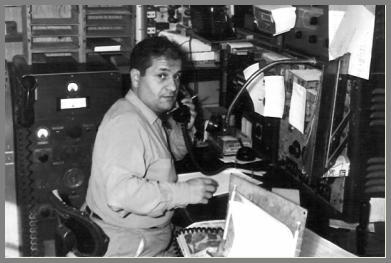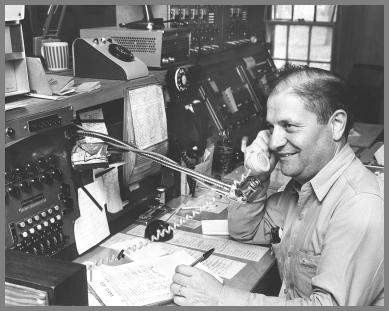
WJG - Memphis, TN

The idea
for WJG, the first radiotelephone station on the inland rivers, was the
brainchild of two men: Loyd J. Carlson was the Chief Engineer and the
technical brains while Russell V. Warner provided the funds
and industry connections. Not much is known about Carlson as
he left the station in 1945. Warner was known by the men on
the river as "Skipper," He began his career in 1908 as a
15-year-old coal passer. By 1913, he had earned his first
river pilot's license. Ten years later he brought the first
commercial towboat through the then newly-opened Lakes-to-Gulf Waterway
into Chicago. Later, he piloted the first diesel towboat, the
Mary Elizabeth, on the lower Mississippi River. In
the 1930s he and George H. Tamble combined their river related
businesses to form the firm Warner and Tamble.
Though
the federal government
used CW for communication with it's boats, prior to 1936, commercial
towboats on the inland rivers had no way to communicate with those
ashore. If the boats needed provisions or assistance in an
emergency, they had no recourse but to keep on steaming until they
reached the next town or settlement. Carlson and Warner
realized that installation of radios aboard the towboats and ashore
could potentially save money and lives. But getting a
Ship-to-Shore radiotelephone station authorized in 1936 took some
doing. The 1937 FCC Annual Report indicates that R. V. Warner
and G. H. Tamble applied for a radiotelephone station at
Memphis on 2558 KHz. The application was heard before an examiner on May 7, 1937, but on April 13, 1938 it was denied because the
Commission had allocated 2558 to New Orleans. However, the
Commission suggested a re-application for 2538 KHz would
likely be
favorably received. The 1939 report indicates that a station at Memphis
had
been licensed. When it came on the air, WJG was an AM
operation on the HF (high frequency or shortwave) bands. Could 1936-1938 operation have been
experimental?
In a 1977
interview, Warner said, "I remember that the government didn't want to
give us a license for two-way radios. They said there was no
need for it. But other fellows," he continued, "didn't think so, and so
we got Old Man McKellar (Senator Kenneth McKellar, the dean of the U.S.
Senate at the time) to pull a few strings and that helped change a few
minds. Once we got the go-ahead, radios went like
wildfire."
Much of the information about WJG's early years was provided by Jack Estes and his recollections are interesting reading both for additional information about WJG (including the early frequencies) but also about the early years of other river stations.
 WJG's First Location on a Memphis Harbor Barge |
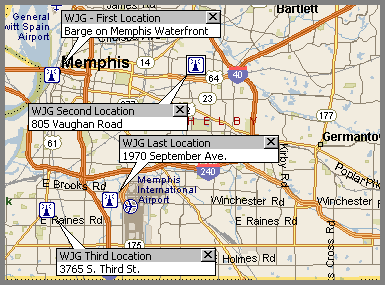 |
|---|---|
John Gill has provided this more detailed (ca 1949) photo of WJG's first home, the Warner and Tramble barge. The barge roof lettering reads: WARNER AND TRAMBLE RIVER EQUIPMENT SHIP TO SHORE RADIOTELEPHONE "WJG"
G. H. Tamble was not actively involved with the WJG part of W & T, and according to his obituary died in 1951. Warner continued to run WJG as well as the thriving towboat business. Here, courtesy of Jerry DeGregory, Jr., is a 1967 WJG advertisement which ran in the >Waterways Journal, and an enlarged view of the photos from that ad with caption information added. The ad includes the only photo we have of "Skipper" Warner.
Warner retired in the late 1960s, and passed away in 1983 - see his >obituary. In late 1968 or early 1969 he sold WJG to Raymond Gartman, the owner of WGK and WCM. Gartman operated the station for 3 years and made many improvements. He sold to Terrence B. ("Bill") Miller (W4JLA) in 1971 and Miller owned the station at least through 1982. There is more about the station during Miller's ownership in this 1982 newspaper article. Mark Gartman worked both for his father and for Bill Miller, and his recollections provide much information about his father's ownership of the three river stations and his own working years at both WGK and WJG.
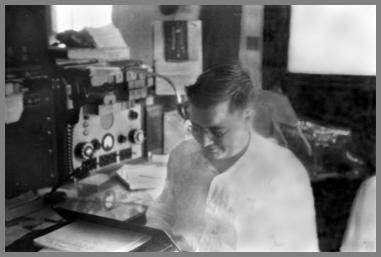 Jimmy DeHart Operating WJG - Late 1940s Jack Estes Photo |
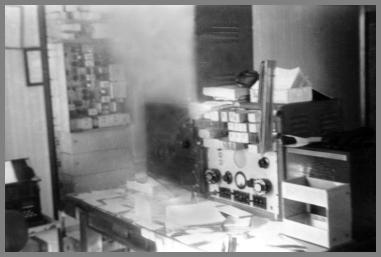 WJG Operating Console - Late 1940s Jack Estes Photo |
|---|---|
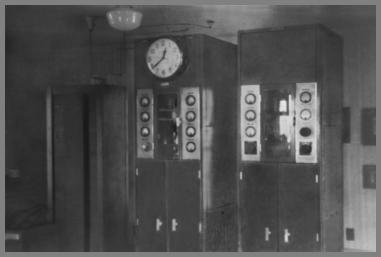 WE-14C 400 Watt AM TX at WJG's Second Location - Jack Estes Photo |
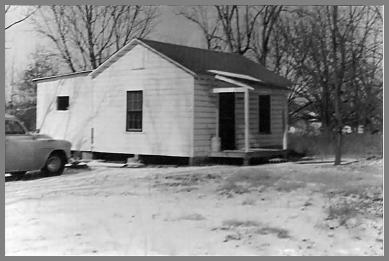 WJG shack - Pecan grove location - About 195? - Photo Courtesy of J. L. DeGregory, Jr. |
|---|---|
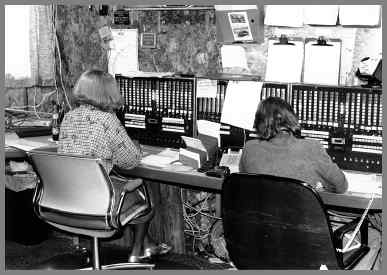 WJG Operating Room - Hwy. 61 Location |
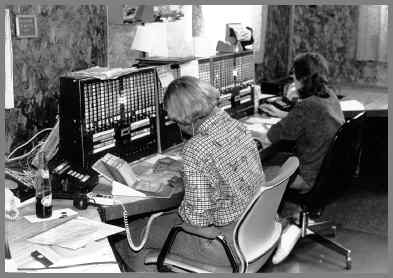 WJG Operating Room - Hwy. 61 Location |
|---|---|
These 1989 views of the
second-floor
operating room show the two operators sitting before a Christmas
tree-like control panel of flashing red, yellow, green, and white
colored lights. Routinely, they completed over 8,000
ship-to-shore telephone calls a month - by 1989 most of them via a 13
station network of VHF-FM stations Map and
Frequencies remotely
controlled from the Memphis operating room. During the winter
months, this total went up even higher as mariners rushed to get their
cargoes and boats out of the upper Mississippi and Illinois rivers
before they were frozen in. Next to the console was the
handset for the SSB equipment (on the first floor) and its SELCAL
(ringer) gear. Out of sight behind the operators a small PC
on wheels kept track of the locations of towboats, and compiled
information on cargoes, barge transfers, etc. This information was then
passed on to the towboat and barge owners. Just outside in
the next room, an old National Weather Service teletype
clickety-clacked with information on river stages and other
meteorological information of interest to the rivermen.
Here are some views of WJG's antennas and building at the Hwy. 61 location. The station wasn’t very visible from the highway, and there was a only a small one lane road leading to the area where the station was housed.
WJG's old Channel 5 (2782 KHz) was by far their most used channel in the late 1940s. Later on additional frequencies were utilized the most common being 6455 (AM) for daytime operations. The small white chart on the SSB transceiver cabinet below lists 6 channels. Not all the numerals are readable in the original photograph and some have been erased, but the line-up was something like the following:
Frequency -
WJG Ch. # However, the business card below also mentions a Channel 7 so the chart doesn't tell the whole story. 
Here's a 1959 QSL card
courtesy of Jeff Yates |
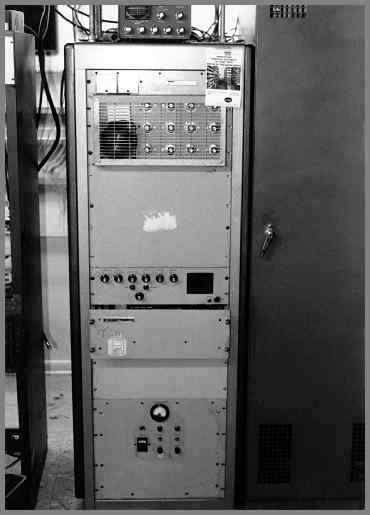 WJG's 1KW CAI HF Transceiver - 1989 |
|---|---|
WJG's license must have had some unique license provisions or it received some special authorizations from the FCC, for over the years, this marine station provided an unusual variety of communications services. In the 1970s, a mining expedition contracted with the station to provide them a means to contact their home office from a remote location in the mountains of Colorado. Before satellite communications were common, WJG was the expedition's only link with the outside world for over six months.
The mammoth overnight delivery service Federal Express has its global headquarters in Memphis. WJG operators were sometimes called by FedEx planes with requests to hook them up for phone calls with the home office.
Stanley Adams, W4SBA reports that WJG was also a licensed (certified?) frequency monitoring station. Via its frequency standard it provided area AM-FM and TV broadcasters with their required monthly frequency checks.
WJG was an informal operation. The operators were known by name to the boat captains.
In the later years of operation WJG and the 13 Station VHF-FM network were sold to Maritel. One of the operators recalls that several of the former WMI/LEC Great Lakes stations that Maritel bought were controlled from Memphis. Unfortunately, we don't know when Maritel took over the operation of the station and network.
After over 60? years of service on HF WJG shut down its 4 MHz SSB operations in 1994. The manually operated VHF-FM station network also ultimately fell victim to satellite and cell-phone competition, and was discontinued in 1995. However, the Bits and Bytes Newsletter carried this notice in 2003: "Maritel, Inc., which, along with its predecessors, has operated marine voice service for 30 years is discontinuing the service effective June 6. The company attributed the action to new more efficient technology that has emerged in recent years, and said "Marine VHF radio equipment simply has not evolved to meet market standards."
